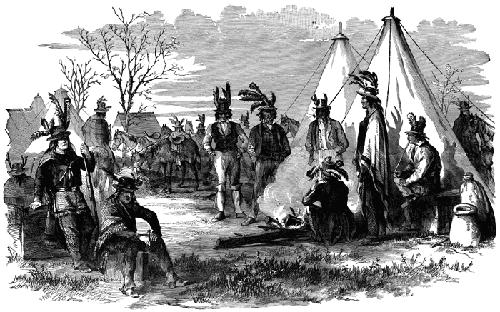One source we consulted states that the English allowed the Dutch to name both the Delaware River and the Delaware Bay in honor of Lord de la Warr who was believed to have discovered both on his voyage to Virginia in 1610. It has since been proven that Lord la Warr never made it this far north, but the name stuck and over time de la Warr became Delaware.
1613-1614–People knew it was there, but the Delaware River and Bay were first explored by Captain Cornelius Hendricksen, aboard the boat called "Onrust" ("Restless"). Hendricksen is regarded by many to be the first "civilized man" to set foot in what is now Delaware. In his journal, he records that he traded with the Indians for skins of various kinds; sables, otter, mink, bear robes, etc. The forests, he said, were alive with game, bucks, does, turkeys and partridges.
At Christiana Creek, he landed and walked over land that was "destined to be covered with the streets and buildings of the city of Wilmington." There he met a band of Minquas Indians. Hendricksen "relieved" the Indians of the three white men in their capture. Apparently these "not-quite-as-civilized" men had fled the Dutch fort near the site of Albany, NY in the spring of 1616. They wandered up the Mohawk Valley, crossed the dividing ridge to the headwaters of the Delaware, descended that stream to Delaware where they fell into the hands of the Minquas who kindly made prisoners of them.
1638–A band of Swedes, led by Peter Minuit, set sail for the New World. At about the end of March, the Kalmar Nyckel (Key of Kalmar) and Vogel Grip (Griffen) land at "The Rocks" on the Christina River (in present day Wilmington). On this site, a fort was built and named Fort Christina after the young queen of Sweden.
Swedish governor Colonel Johan Printz ruled the colony under Swedish law for ten years (1643-1653). Printz was succeeded by Johan Rising.
1654–Johan Rising arrives in the new world, promptly seizes the Dutch post, Fort Casmir which had been built by the governor of the Colony of New Netherlands in 1651.1655–Peter Stuyvesant, from New Amsterdam, arrives with the Dutch fleet. The Dutch forces overpowered the Swedish forts, and established the authority of the Colony of New Netherlands throughout the area, thus marking the end of Swedish rule in Delaware.
Following the seizure of the colony of New Sweden, the Dutch restored the name Fort Casmir and made it the principal settlement of the Zuidt or South River. The area within the fort was not large enough to accommodate all the settlers. Soon, a town, New Amstel (now New Castle), was laid out.
October 27, 1682–William Penn lands in America, at New Castle, where he promptly takes possession of the lower counties from the Duke of York’s agents. On this occasion, the colonists pledge an oath of allegiance to Penn, and the first general assembly is held in the colony. The three Lower Counties (now the entire state of Delaware) were annexed to the Province of Pennsylvania as territories with full privileges under Penn’s famous "Frame of Government."
1776–At the time of the Declaration of Independence, Delaware not only declared itself free from the British Empire, but also established a state government entirely separate from Pennsylvania.
September 3, 1777–The only Revolutionary battle on Delaware soil is fought at Cooch’s Bridge, near Newark. The colonial wars had built up the militia system and supplied a number of capable officers who led the Delaware troops (nearly 4,000 men in total) in all of the principal engagements from the battle of Long Island to the siege of Yorktown.
1785–Oliver Evans of Newport, Delaware, invents automatic flour milling machinery, revolutionizing the industry. His invention would become an important stimulus to the recovery of the state’s economy after the revolutionary war.
December 7, 1787–In 1786, John Dickinson of Delaware presided over the Annapolis Convention, which called for the Federal Constitutional Convention. When the new Constitution was submitted to the states for ratification, Delaware was the first of the thirteen original states to ratify the Constitution of the United States. This unanimous ratification took place in a convention in Dover on December 7, 1787, whereby Delaware became "The First State" of the new Federal Union.
March 13, 1899–The General Assembly passes "An Act Providing a General Corporation Law." With passage of this bill, Delaware effectively set out the welcome mat for America’s corporations. To this day, many of the world’s largest corporations are incorporated in this state.


No comments:
Post a Comment